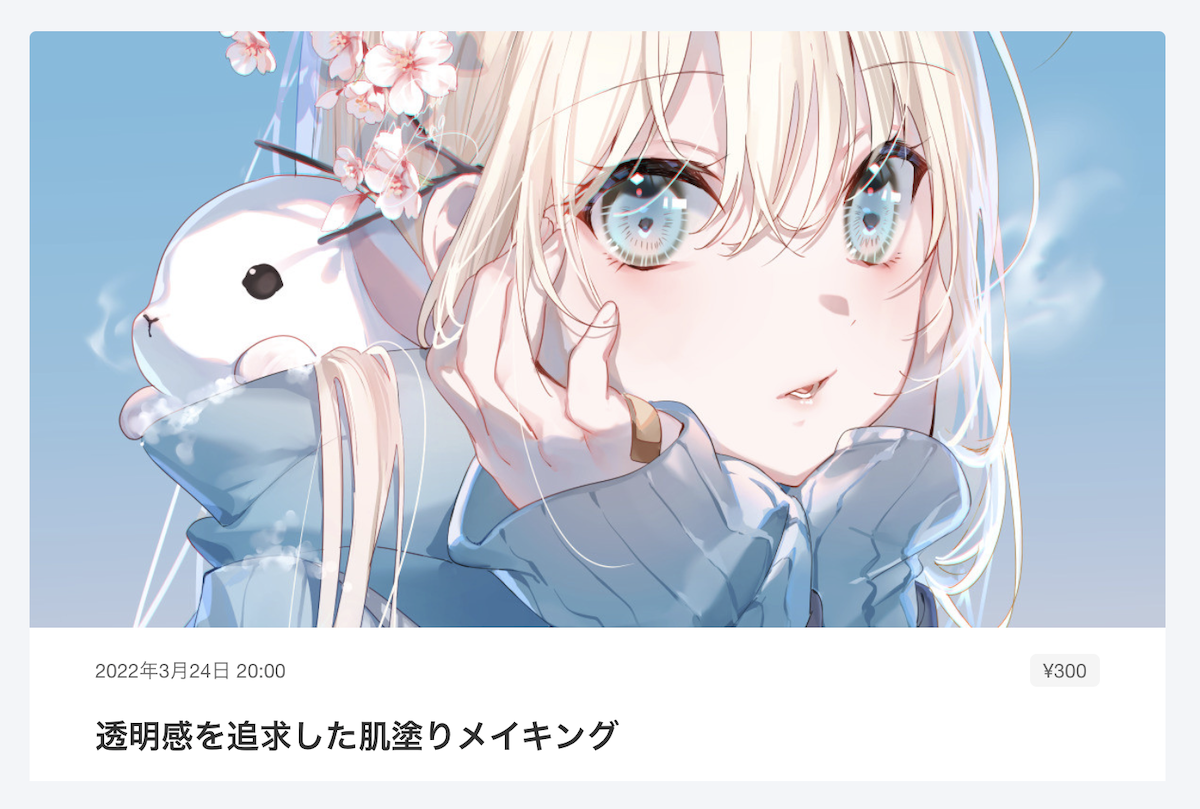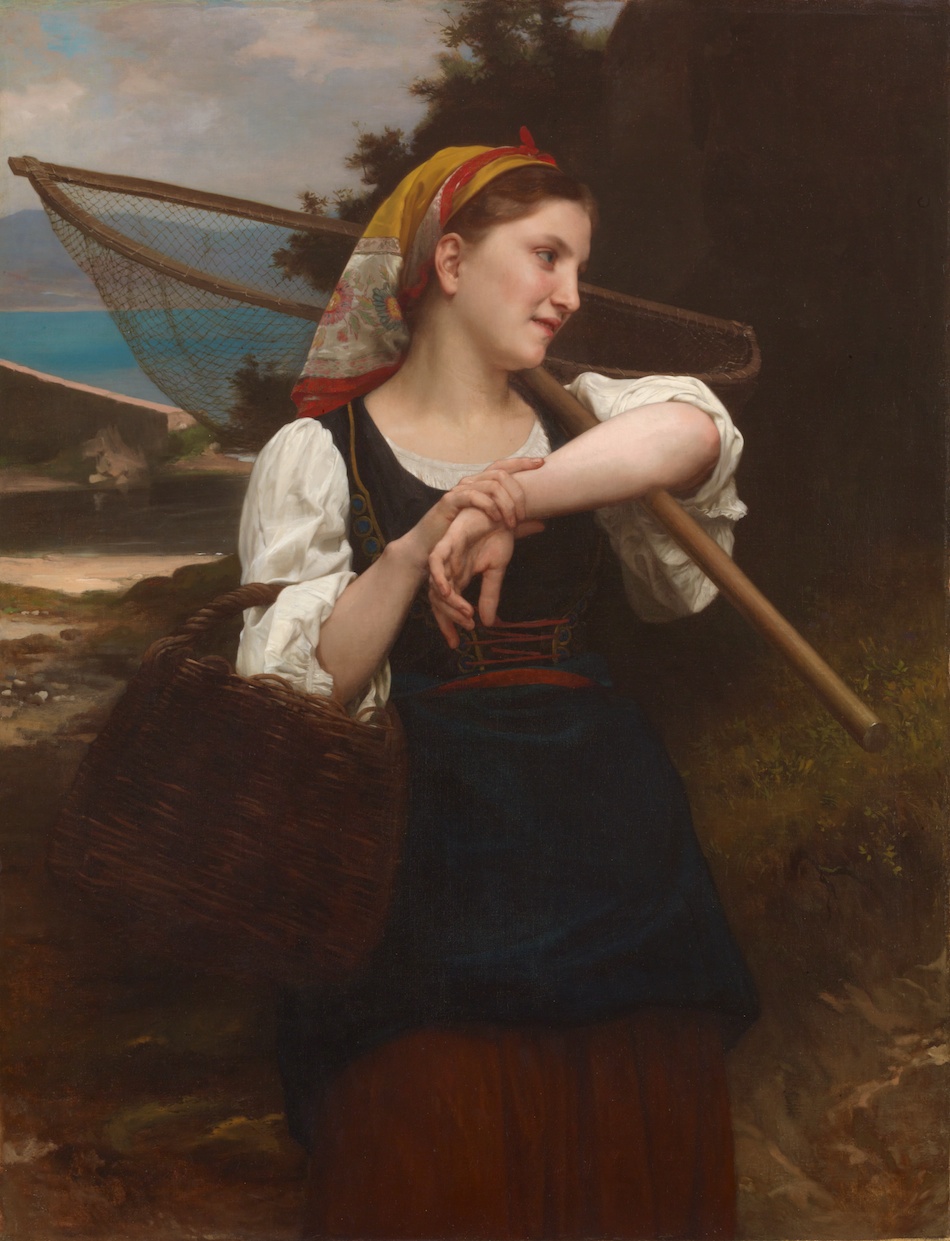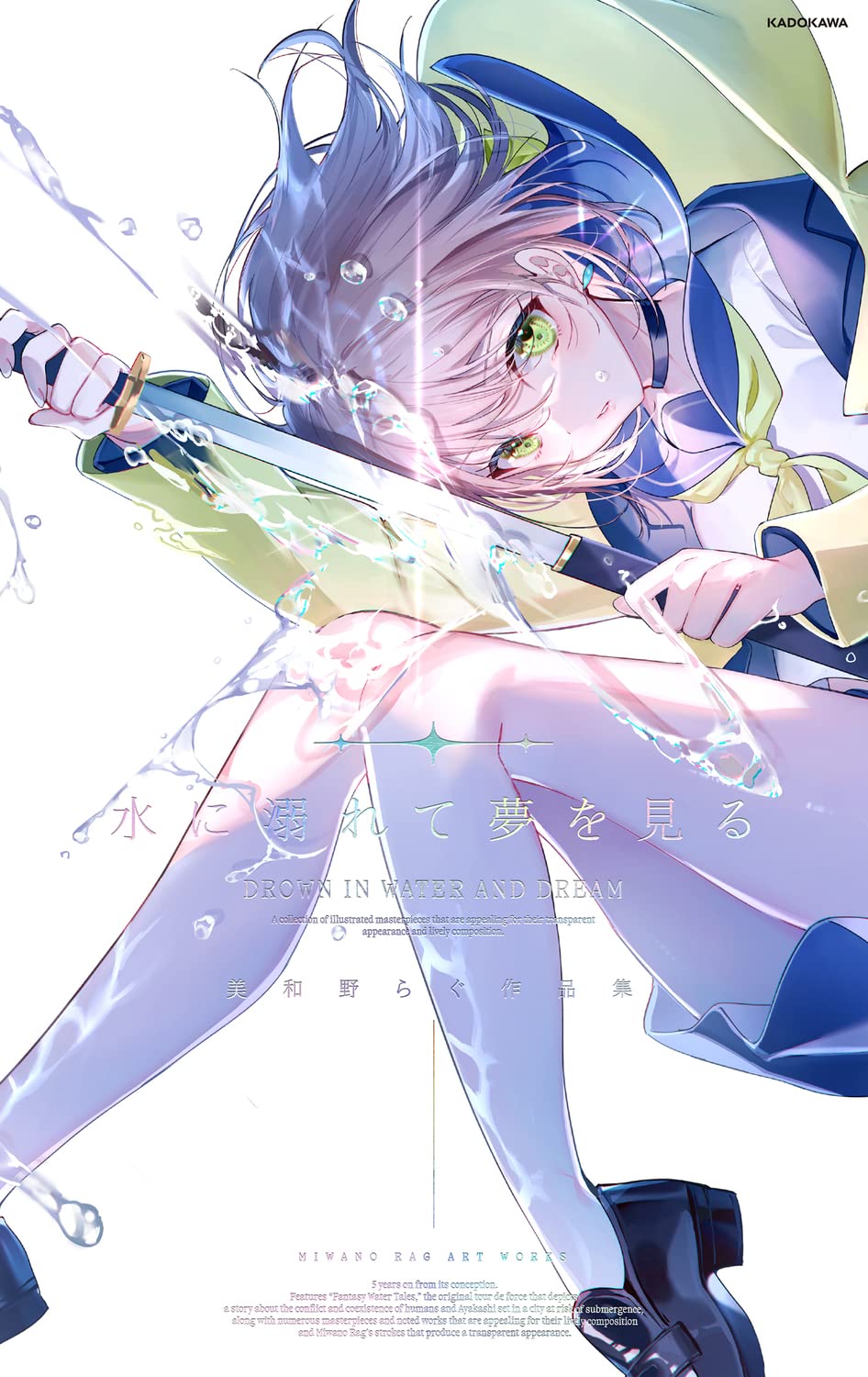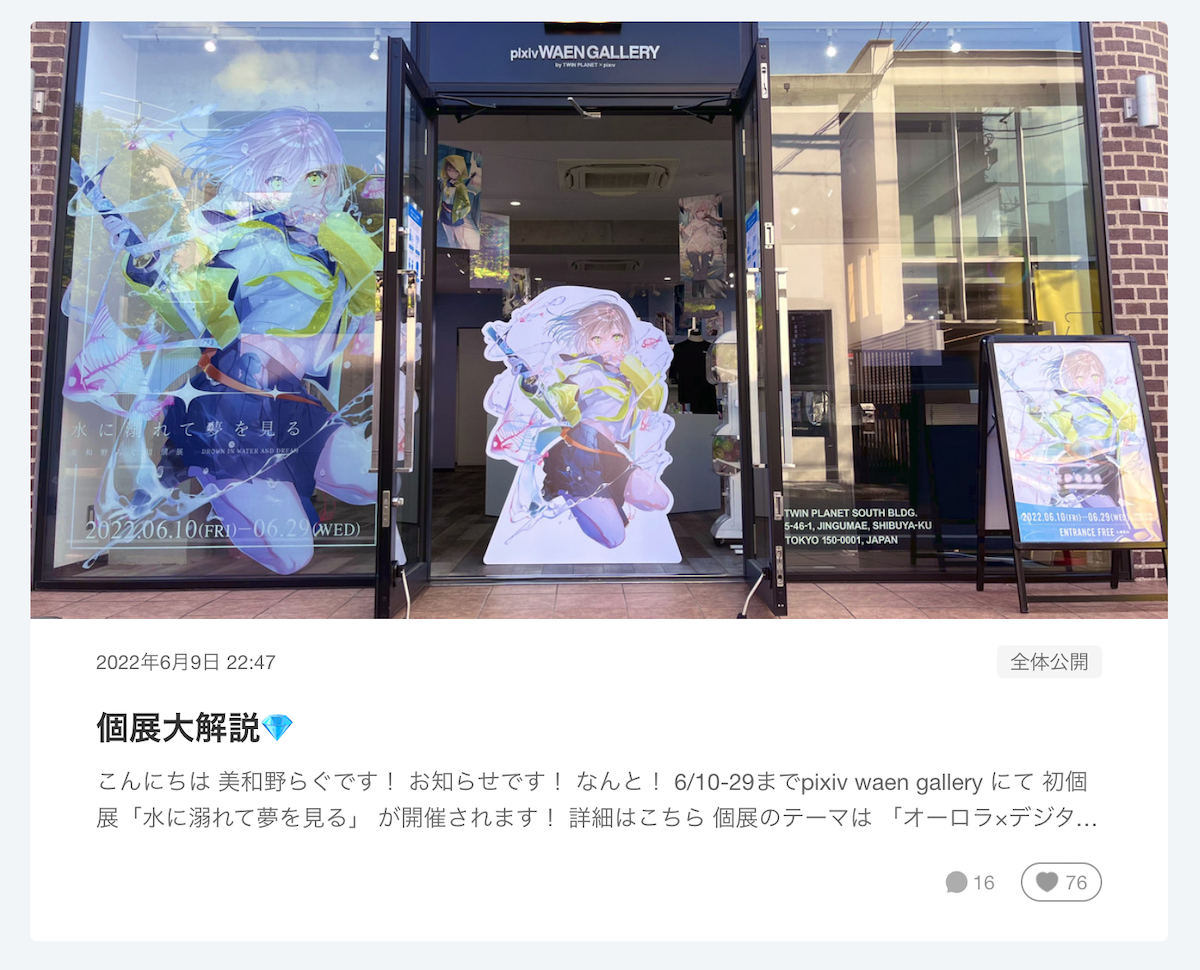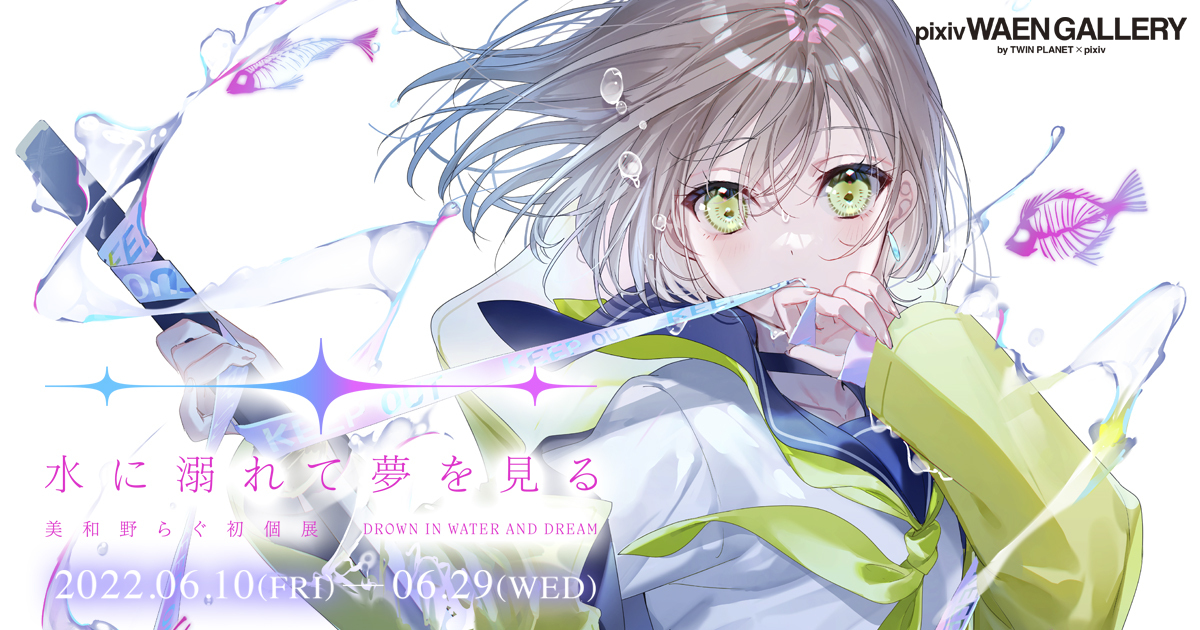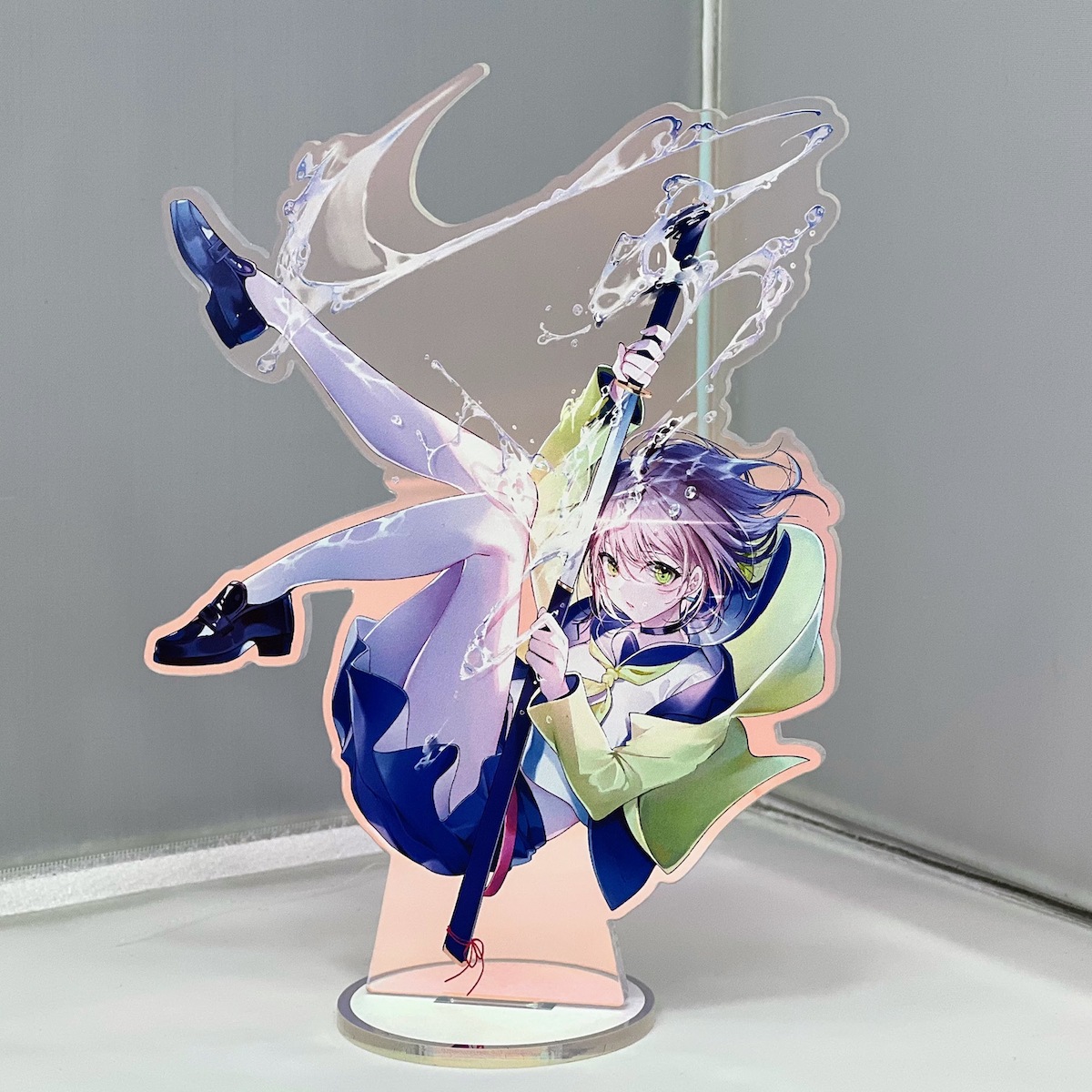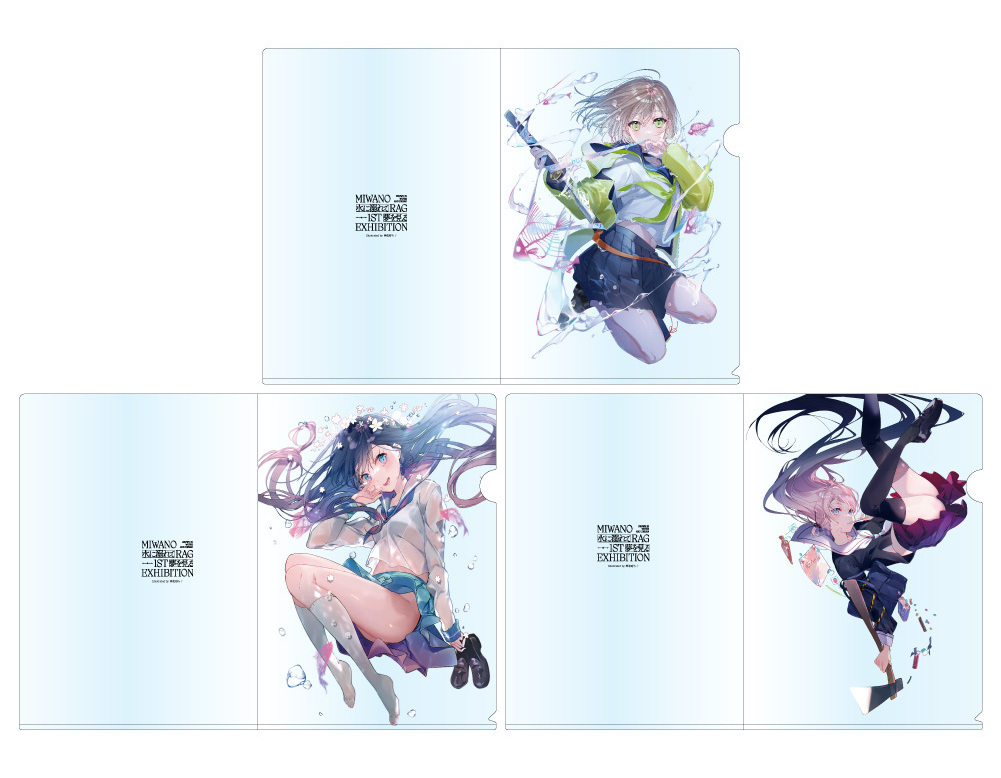「見せたいもの」を際立たせる。イラストレーター美和野らぐに「ポーズと構図へのこだわり」を聞いた
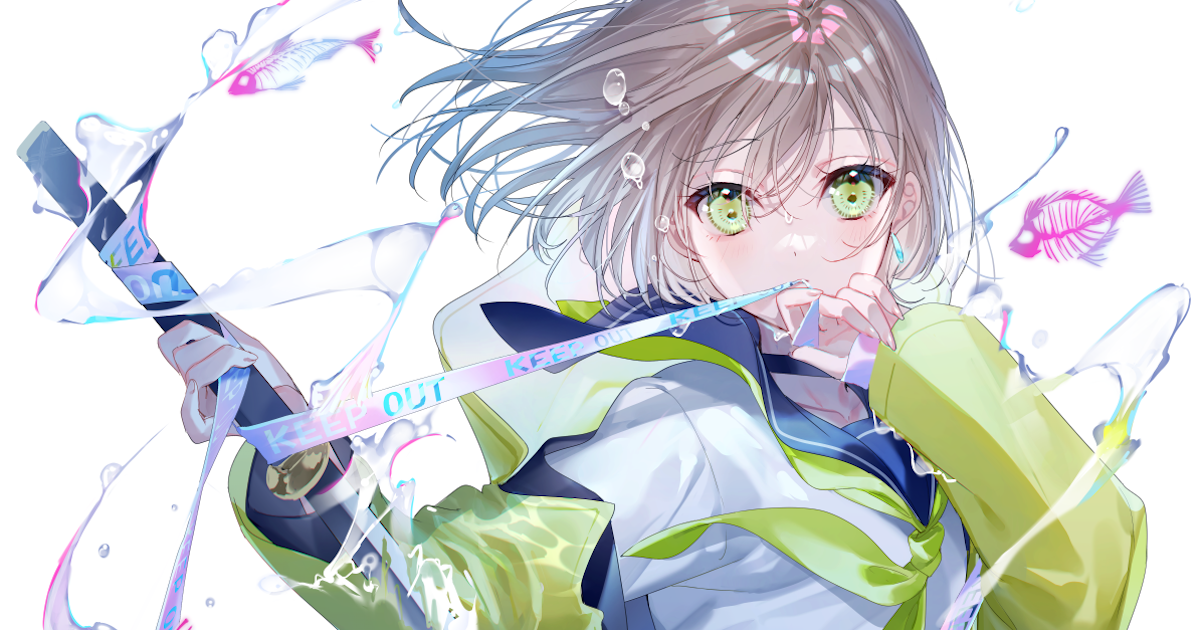
インタビュー/原田イチボ
イラストレーター美和野らぐさんの初個展「水に溺れて夢を見る」が、東京・表参道にある「pixiv WAEN GALLERY」にて2022年6月29日(水)まで開催中です。
3月に発売された初の作品集『水に溺れて夢を見る』収録のイラストのほか、個人制作シリーズ『幻妖水奇譚』の新作イラストなど約150点を展示します。

美和野さんは、イラストを描くとき、キャラクターのポージングや構図を重視していると言います。それらへのこだわりの裏には、アニメーターとして働いた経験や、2歳から続けているバレエがありました。
高校時代のホームステイが転機だった
── アニメーターを経て、フリーランスのイラストレーターになったそうですね。子どもの頃から絵を描く仕事にあこがれていたんですか?
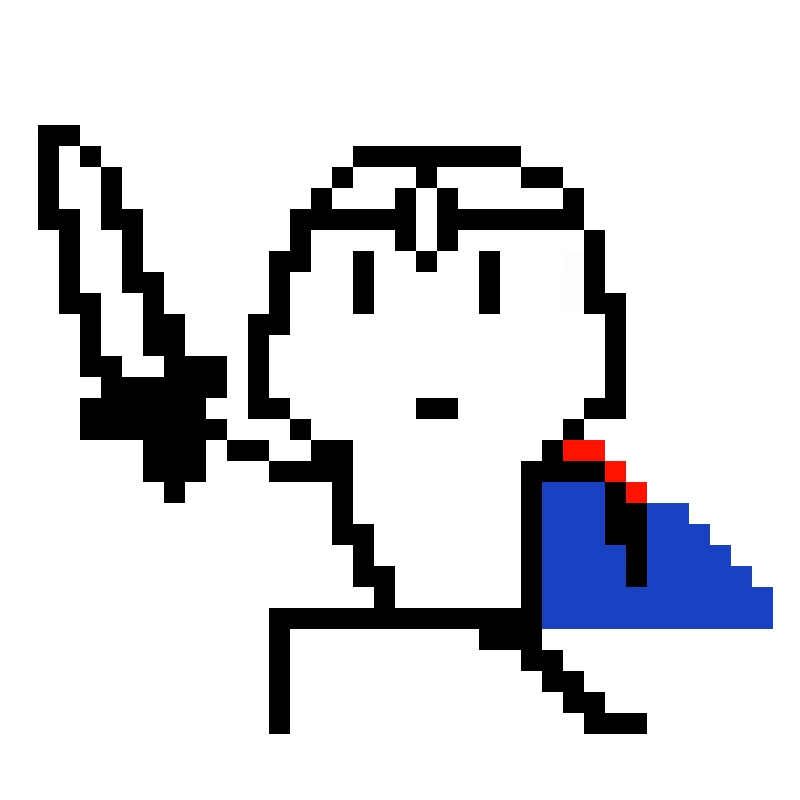
── 思い切りのいい人生ですね……!

── とはいえ、アニメスタジオの採用に合格するくらいですし、趣味といえど相当の量を描いてきたのでは?

── すごいですね。現在、フリーのイラストレーターになって何年目ですか?

── 自信作以外もアップしていたのでしょうか。

まずは投稿しないと「イラストレーター美和野らぐ」を知ってもらえませんからね。少しでも露出を増やすことが大事だと考えました。
透明感のある塗りは、西洋絵画がルーツ
── 現在の作業環境を教えてください。

ソフトはCLIP STUDIO PAINT EXです。線画は液タブのWacom Cintiq Pro 24、色塗りは板タブのWacom Intuos Pro Mサイズを使っています。液タブだとつい姿勢が悪くなってしまうので、姿勢を矯正する目的で使い分けています。
デジタル作画歴は10年ほどですかね。受験直前に板タブを買ったので、母親からすごく怒られた記憶があります(笑)。
── 美和野さんといえば、透明感のある作風ですよね。イラストに透明感を出したいなら、どんなところを意識するといいでしょうか?

── 薄い色と濃い色のコントラスト?

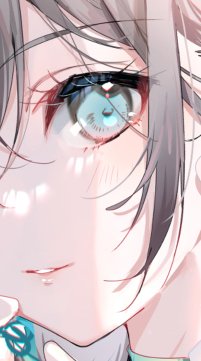
── 光の表現にこだわるイラストレーターさんはカメラを趣味にしているイメージがありましたが、美和野さんが描く光のルーツは水彩画や油彩画にあるんですね。

絵画の中でも特に印象に残っているのは、ウィリアム・アドルフ・ブーグローの「漁師の娘」という作品です。中学生時代、この作品にすっかり恋して、ポストカードを大切にしていました。
ウィリアム・アドルフ・ブーグロー「漁師の娘」 1872年(東京富士美術館所蔵)
絵のどの部分がメインで、どの部分がサブかを明確にする
── アニメーターの経験が現在も活きていると感じることはありますか?

アニメーター時代の上司に「アニメで一番大事なのは目だ。画面をぱっと見たとき、まずキャラクターの目に視線が行って、それから初めて周辺に意識が向くんだ」と教わり、今もイラストを描くときは目を意識しています。
── 「目を意識して描く」とは、具体的にどういうことでしょうか?

視線誘導と言うと少し難しく感じるかもしれませんが、要するに「絵のどの部分がメインで、どの部分がサブかを明確にする」ということですよね。全部が全部きっちり描き込むと、どこを見ていい絵なのかわからなくなっちゃいますから。で、キャラクターの目、つまり顔は一番目立たせたい部分なんですよ。だから彩度が高い色や、手を顔の近くに配置する。逆に彩度が低い色などはメインから離れたところに置いて、その箇所はあまり描き込まないようにします。顔まわりの情報量を高くして、そこから離れた部分は「抜く」イメージですね。
── 美和野さんのイラストは、背景などにぼかしを効果的に使っていますよね。それも「抜く」方法の一種ですか?

── ほかにアニメーター時代に学んで今も役立っていることはありますか?

── 絵を描き始めた頃はどんな練習をしていましたか?

ポーズから考えて、それが映える要素を足していく
── 美和野さんは構図や、キャラクターのポーズを重視してイラストを描いていると聞きました。良いポーズとは、どんなものでしょうか?

── どのように組み立てていくことが多いのでしょうか。

ただ座っている姿にしても、手を顔の近くに持ってきたら顔に焦点が当たります。そして座っている膝に花を置くと、そこもポイントになる。まず何を見せたいか決めないと、構図も決まりません。モチーフやテーマをスタート地点にして絵を描く人が多いとは思うんですが、私はポーズを最初に考えて、そこからポーズが映えるような要素をどんどん足していきます。あくまで自分の場合ですが、テーマから絵を描き始めると、どうしてもテーマの範囲に収まった仕上がりになってしまって、突出したアイデアが生まれない気がするんです。
── ポーズを最初に考えて、それが映えるように要素を足していくということですね。


── なるほど。「この縦のラインを見せるイラストにしたい」という意図から逆算して細かい部分を決めていくんですね。あとは美和野さんは作品のタイトルにもこだわっていると聞きました。

── 作品を完成させてからタイトルを決めるのではなく、アイデアをふくらませたり、作品の世界観をまとめる機能としてタイトルを使っているんですね。

そうですね。
── イラストレーターさんは、「こういうモチーフを描きたい」というビジュアル先行か、「このキャラはこういう子で、この世界はこういう世界で……」という設定先行のどちらかに分かれる印象だったので、そういう描き方もあるのかと驚きました。

以前メイキング映像を公開したとき、「変わった描き方をしますね」と驚かれました(笑)。ラフの途中で線画を描き始めて、線画の途中でラフに描き足して、描き足したぶんを線画に反映しつつ、一部を塗り始めるみたいな……。描きながらアイデアがふくらんでいくので、ついラフと線画を行ったり来たりしちゃうんですよ。普段の仕事でも、可能な限り、ラフをガチガチに決めすぎないまま進めさせてもらっています。
Wacom Cintiq Pro 24を使った美和野さんのライブペインディング「Drawing with Wacom」
動画と関連した美和野さんのインタビューはこちら
── スランプになったときはどうしていますか?

人間と「あやかし」の戦いと共生を描いた『幻妖水奇譚』シリーズ
── 個人制作シリーズ『幻妖水奇譚』について教えてください。

── 人間の秘密組織「鬼」や「あやかし」など登場人物が多く、群像劇としても楽しめます。特に思い入れのあるキャラクターはいますか?

「鬼」の一員でありながら「あやかし」の血を引く主人公の水野ナギです。ナギちゃんは、『幻妖水奇譚』を制作する前から描いていたキャラクターで、ショートヘアにチョーカー、脚と私の好みが詰まっています(笑)。
── 3月に発売された初めての画集も、今回の個展も『水に溺れて夢を見る』というタイトルですよね。

画集を出版したKADOKAWAの担当さんと「これまでのイラスト作品と幻妖水奇譚を踏まえてどんなタイトルがふさわしいのか?」と話し合いました。その結果、やはり私の作品は「水」というのがひとつの大きな要素になっているのかなと。さらに幻想的な雰囲気を「夢」という言葉に託し、このタイトルになりました。水に溺れた瞬間に見た夢、というイメージです。
── オーロラ素材をあしらうなど、個展会場は美和野さんの作風を再現したような雰囲気に仕上がっています。

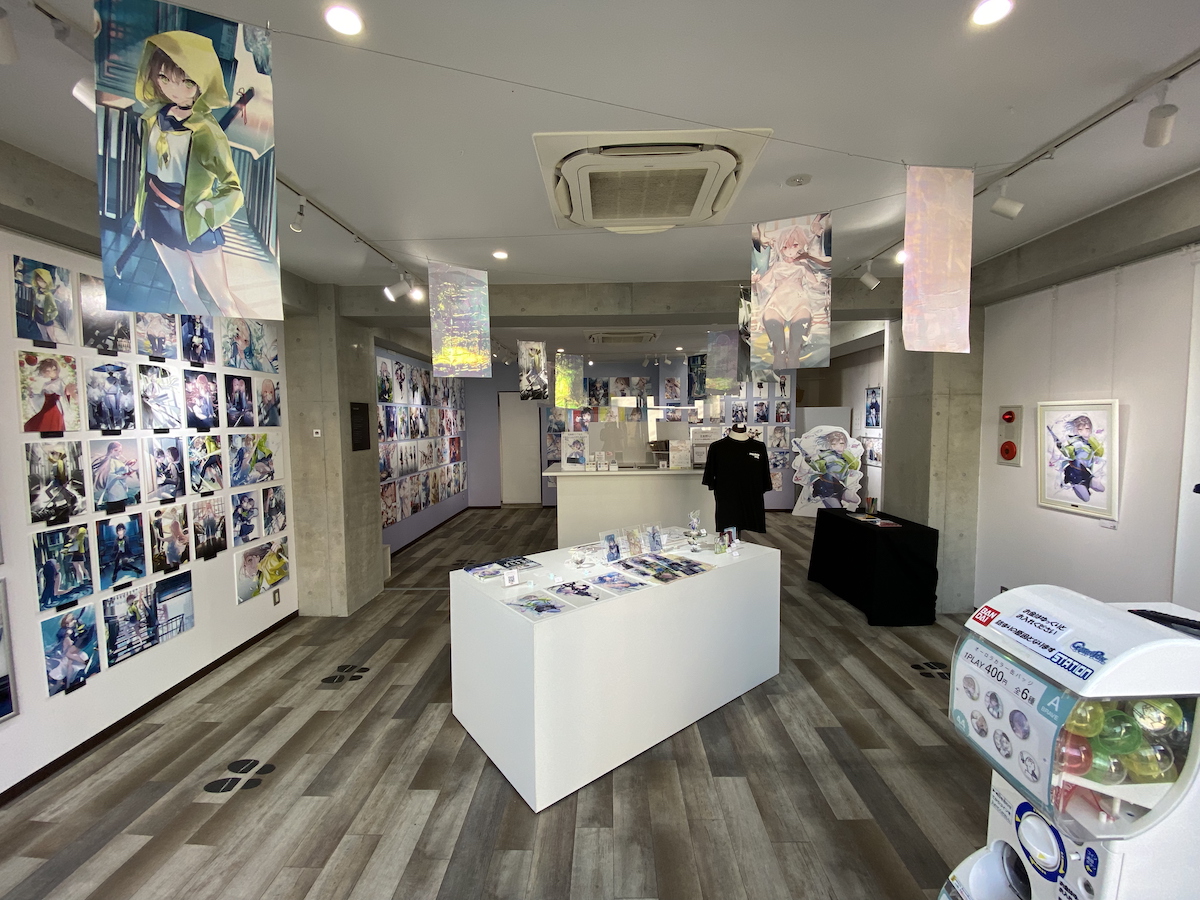
── 「美和野さんは素材への感度が非常に高い」と個展の担当者から聞きました。

きっかけは『青の祓魔師』のBlu-rayでした。銀の紙がすごく印象的で、当時、「この紙はなんですか? 私もこれで本が出したいです」と印刷所に問い合わせました(笑)。そこからすっかり「沼」にハマって、コンビニのお菓子売り場を眺めて「この素材にこの加工……。この箱はコスト高いぞ!」なんて考えています。せっかくの作品なので、紙自体にも世界観があったほうが楽しいじゃないですか。よくお願いするデザイナーさんも沼の仲間なので、「この素材なら、あえて線画だけにしたほうが映えるんじゃないか」など提案してくれます。
── 細部にまで美和野さんのこだわりが詰まった個展、とても楽しみです! しかし3月に発売された画集と個展をもって、『幻妖水奇譚』は一区切りなんでしょうか?

── FANBOXにて、美和野さんご自身による個展の解説もあげられています。そちらもぜひご覧ください!
6/29(水)まで! 美和野らぐ初個展「水に溺れて夢を見る」開催中
pixivとツインプラネットが共同運営するギャラリー「pixiv WAEN GALLERY by TWINPLANET × pixiv」にて、美和野らぐさんの初個展「水に溺れて夢を見る」が2022年6月29日(水)まで開催中です。
オリジナル、商業イラストを含め、約150点のイラストを展示します。美和野さんが歴代の作品から特に印象深いイラストを選び作成したアクリルアートなど、展示方法にもこだわっています。美和野さんのイラストの透明感を象徴する「水」をテーマに、透明感のある素材やオーロラカラーを用いたグッズの販売もございますので、ぜひお立ち寄りください。
開催期間:2022年6月10日(金)~6月29日(水)
定休日:なし
入場無料
所在地:東京都渋谷区神宮前5-46-1 TWIN PLANET South BLDG. 1F
営業時間:12:00~19:00
※混雑時は整理券対応をさせていただく可能性がございます。あらかじめご了承ください。
※新型コロナウイルスへの対策について
美和野らぐ個展「水に溺れて夢を見る」について、現時点では6月29日(水)までの開催を予定しております。今後も状況を注視しながら対応を進めてまいりますが、新型コロナウイルスの感染状況などにより、開催期間に変更が生じる場合がございます。販売商品や来店方法等を含め、運営状況については、随時pixiv WAEN GALLERY公式HP、公式Twitterにてお知らせさせて頂きます。何卒ご理解賜りますよう、重ねてお願い申し上げます。
グッズのWEB販売も!
BOOTHにて個展販売グッズの一部をご購入いただけます。美和野さんの絵柄に合わせ透明素材で制作したグッズなどをぜひご覧ください。




